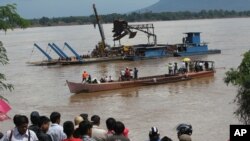Asia Pacific aviation experts are calling for more emphasis on pilot training as countries in the region prepare for rapid growth in passenger flights in the coming decades. Lao Airlines released the official report into the cause of the crash of a domestic flight last October that killed all 49 passengers and crew including foreigners.
Lao Airlines flight QV 301 was flying from the capital Vientiane to Pakse in southern Champasak province in October 2013 when the twin-engine turboprop crashed in a heavy storm on its second landing attempt.
The tragedy killed everyone on board, including nationals from 10 countries, including Australia, France, Thailand, South Korea, Vietnam, China, Taiwan and the United States.
Last Friday the Lao Government released the official report into the accident to the Lao media as well as relatives of the victims specially invited as guests of Lao Airlines.
Pilot error
Details were also broadcast on Lao TV. The TV report told how in the midst of a storm the pilot had at the last minute decided to halt the descent to the airport, to attempt a second landing but at an altitude below recommended levels and in a steep right turn.
Instead, the plane clipped trees on an island in the Mekong. Its fuselage struck the bank and the plane plunged into the river. All on board perished on impact, the report said.
The victims included an Australian family of four, Gavin Rhodes, his wife, Phoumalaysy, originally from Laos, and their two small children.
Gavin's father, Geoff Rhodes, 71, from Sydney, spoke of how he had wanted to 'represent' his son at the report's release. He summed up the report's findings.
"My interpretation was that there were three errors; pilot error, system error, and equipment error. And the recommendations that they are making as to how they can improve seem to me to try and consider all three. Does it make any difference to how I feel? No. No I don't feel any different," Rhodes states.
The report on the tragedy comes as the Asia Pacific aviation industry is seen on a pathway for rapid growth in the coming decades.
Call for safety measures
The International Air Transport Association (IATA) recently called for the continued strengthening of safety measures and improved low cost infrastructure and environmental controls.
Globally some 3.3 billion passengers are expected to board flights this year, and this is forecast to grow to 7.3 billion by 2034. IATA says that over the coming two decades the Asia-Pacific is expected to account for about two thirds of global growth.
But Hugh Ritchie, chief executive of Aviation Consultants International, says growth is often outpacing the region's aviation sector's capacity to build up skilled human resources to cope with the rapid changes.
"My problem with air safety in this part of the world is that they are growing exponentially. They are trying to build systems which are international standards. On the outside it looks like they are doing it but if you go behind the scenes and look at much of the functionality, I don't think they are achieving these levels," Ritchie explained.
Ritchie says too often in Asia there is a hesitation to make key decisions that will impact the Asia Pacific aviation industry going forward. Some efforts are underway.
The Asia Pacific Regional Aviation Safety Group, of 20 governments and 12 international organizations, including IATA, is improving the sharing of critical safety information. Institutions such as the Asian Development Bank are providing funds for air safety infrastructure.
The questions remains, is enough being done, quickly enough, to avoid tragedies like the crash of Flight QV 301.








